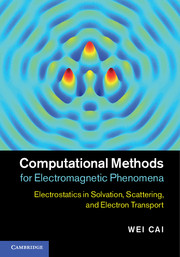 Computational Methods for Electromagnetic Phenomena
Computational Methods for Electromagnetic Phenomena Preface
Published online by Cambridge University Press: 05 February 2013
Summary
Electromagnetic (EM) processes play an important role in many scientific and engineering applications such as the electrostatic forces in biomolecular solvation, radar wave scattering, the interaction of light with electrons in metallic materials, and current flows in nano-electronics, among many others. These are the kinds of electromagnetic phenomena, from atomistic to continuum scales, discussed in this book.
While the focus of the book is on a wide selection of various numerical methods for modeling electromagnetic phenomena, as listed under the entry “numerical methods” in the book index, attention is also given to the underlying physics of the problems under study. As computational research has become strongly influenced by the interaction from many different areas such as biology, physics, chemistry, and engineering, etc., a multi-faceted and balanced approach addressing the interconnection among mathematical algorithms and physical principles and applications is needed to prepare graduate students in applied mathematics, sciences, and engineering, to whom this book is aimed, for innovative advanced computational research.
This book arises from courses and lectures the author gave in various universities: the UNC Charlotte and the UC Santa Barbara in the USA, and Peking University, Fudan University, and Shanghai Jiao Tong University in China, to graduate students in applied mathematics and engineering. While attempts are made to include the most important numerical methods, the materials presented are undoubtedly affected by the author's own research experience and knowledge.
Information
- Type
- Chapter
- Information
- Computational Methods for Electromagnetic PhenomenaElectrostatics in Solvation, Scattering, and Electron Transport, pp. xv - xviiiPublisher: Cambridge University PressPrint publication year: 2013